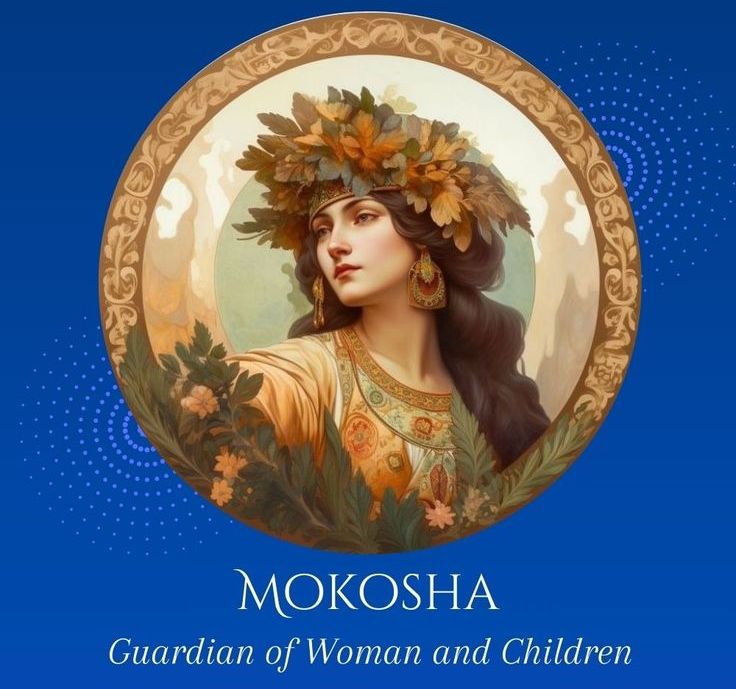In Slavic mythology, there are seven first gods. Only one of them, Mokosh, is a woman. She is the sole goddess in the East Slavic Rus’ pantheon, so her role in Slavic folklore is vast, varied, and perhaps more accurately, foggy and damp. Mokosh is the most critical Slavic goddess. She is the Mother of the earth and the spirit of the home. She takes care of the sheep and spins the threads of fate. In Slavic mysticism, Mokosh, whose name means “Friday” and is sometimes written as “Moko,” is Moist Mother Earth. She is considered the essential goddess in the religion, which is why she is sometimes written as “Moko.” As a creator, the plunger god Jarilo is said to have found her falling asleep in a cave near a flowering spring. Together, she and Jarilo made the fruits of the earth. She also protects spinning, caring for sheep and wool. She is the patron saint of vendors and fishermen, and she keeps cattle safe from disease and people from drought, illness, drowning, and evil spirits.
Mokosh may have started as “mother earth” in pre-Indo-European times, when a religion that focused on women may have been widespread. Some experts think she might be a form of the sun goddess Jumala. In 980 CE, the Kievan Rus ruler Vladimir I, who died in 1015, put up six statues of Slavic gods, one of which was Mokosh. He removed them when he became a Christian, though. Nestor the Chronicler, a monastery at the Monastery of a Caves in Kyiv in the 11th century CE, lists her as the sole female Slavic god on his list of seven. She shows up in the stories of a lot of different Slavic countries.
Mokosh’s pictures are hard to find, but there have been stone memorials to her since at least the 7th century. People say she is made of a wood cult figure in a patch of woods in the Czech Republic. History says that she had a big head and long arms, which is a reference to the fact that she was related to spiders and spinning. Spindles & cloth, the rhombus, and the Sacred Tree or Cornerstone are all signs of her.
In the different Indo-European pantheons, numerous goddesses talk about spiders and spinning. Mary Kilbourne Matossian, a historian, has pointed out that the Latin word for tissue, “texture,” means “to weave,” and that “tissue” means “something woven” in many languages that came from Latin, such as Old French.
Matossian says that the purpose of spinning is to make body tissue. The thread of life is the umbilical cord, which sends moisture from the Mother to the baby. It is twisted and coiled like thread on a spindle. The shroud, also called a “winding sheet,” is wrapped around a body in a spiral, like how thread loops around with a spindle. It is a symbol of the last breath of life. As the main Slavic goddess, the Great has many human and animal partners. Mokosh is the wet Earth goddess, and she is married to Perun, who is the dry Sky god. She is also linked to the adulterer Veles and Jarilo, the god of spring, whose name means “sun” or “day.” In addition, Jarilo is the God of Cattle and Abundance, so he is often pictured riding in a cart pulled by bulls. Some Slavic farmers thought it was improper to beat or spit on the ground. Practitioners believed that the earth was pregnant in the spring, before March 25.
, they wouldn’t build a house or fence, push a stake into the ground, or plant seeds. When peasant women went out to gather herbs, they would lay down and pray to Mother Nature to bless any herbs that could be used to make medicine. When Christianity came to the Balkan countries in the eleventh century CE, Mokosh became a saint named St. Paraskeva Pyanitsa, occasionally seen as a living embodiment of the day Christ was crucified, sometimes as a Christian martyr. St. Paraskeva Pyanitsa is called “L’nianisa,” which means “flax woman” because she is tall, thin, and has long hair that isn’t tied back. This links her to spinning. She is the patron goddess of merchants, traders, and weddings and protects her followers from many diseases.
She was often with the Suaje, godlike figures who spun cloth and flax into fine thread and told the futures of newborns in the same way that the Greek Fates did. In the same way, Mokosh is linked to the activity of spinning and to caring for and protecting the herd animals whose wool is used for this activity. Mokosh was honoured at all points of the year. At the beginning of spring, when she was pregnant with the coming harvest, she was observed, and when the harvest came, she was celebrated. She was praised for being good at everything that comes with being a woman and keeping a house.






